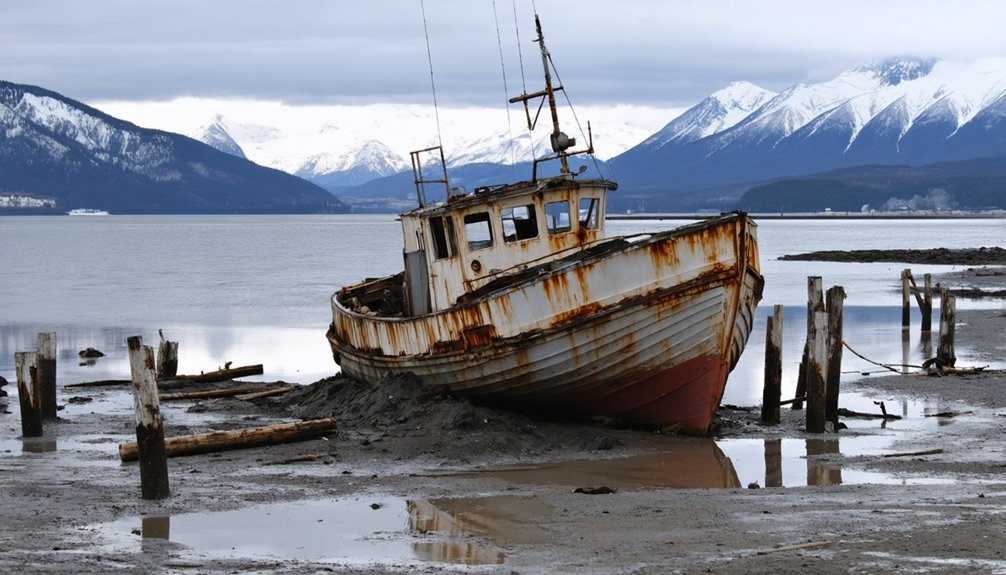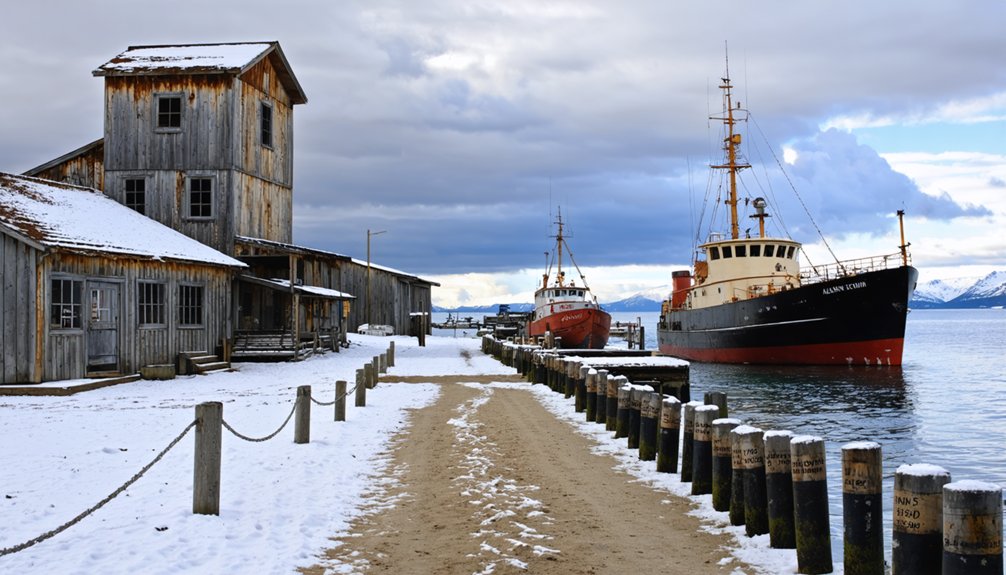You’ll find Port Wakefield‘s haunting remains on Alaska’s Raspberry Island, where Lee Howard Wakefield’s 1930s herring plant evolved into America’s king crab empire. By 1955, the settlement produced 85% of U.S. king crab through innovative processing methods. Everything changed on March 27, 1964, when a devastating 9.2 magnitude earthquake forced the community to relocate to Port Lions. Today, the abandoned site stands as a memorial to Alaska’s resilient fishing heritage.
Key Takeaways
- Port Wakefield was originally established in the 1930s as a herring reduction plant before becoming a major king crab processing center.
- The town became abandoned after the devastating 1964 earthquake, which caused massive soil liquefaction and tectonic subsidence.
- Residents relocated to Port Lions on Kodiak Island in 1966, moving their cedar log houses by barge to the new location.
- The original site of Port Wakefield remains deserted today, serving as a testament to Alaska’s fishing industry heritage.
- The ghost town now attracts tourists interested in exploring Alaska’s abandoned historical sites, though access is limited.
The Rise of Port Wakefield’s Fishing Empire
When Lee Howard Wakefield established Port Wakefield in the 1930s as a herring reduction plant, he laid the foundation for what would become a pioneering king crab empire.
After relocating their Apex Fish Company from Washington, the Wakefields built cedar log houses and a church, creating vibrant community dynamics for their workers.
The Wakefields transformed an industrial site into a thriving community, complete with wooden homes and spiritual gathering spaces for their workforce.
As herring stocks declined, they adapted their fishing techniques, shifting focus to king crab by 1939.
The transformation accelerated after World War II when Lowell Wakefield revolutionized the industry by introducing modern canning and freezing methods. His innovative approach included switching from trawl nets to baited steel traps, ensuring crabs were caught alive and undamaged. By 1955, the operation had grown so successful that it produced 85 percent of America’s king crab catch.
Through Deep Sea Trawlers Inc., founded in 1946, they expanded operations into the Bering Sea, solidifying their dominance in Alaska’s emerging king crab industry. To enhance fishing operations in challenging conditions, they implemented radar technology for locating crab pot buoys.
Life in a Remote Alaskan Community
If you’d lived in Port Wakefield during its peak, you’d have found your daily routine centered around the cannery’s schedule, with workers rising early to process the day’s catch while their children attended the community’s single schoolhouse.
Life moved at nature’s pace, as fishing seasons and weather patterns dictated work schedules, social gatherings, and school activities for the roughly 100 residents. Today, Port Wakefield stands as a ghost town in Alaska. The local population once included Spanish-speaking muleteers who traveled through the area from Monte Video, Uruguay.
Winter brought unique challenges that required careful planning, with families stockpiling supplies and relying on each other to maintain essential services in their remote Alaskan outpost.
Daily Community Routines
Life in Port Wakefield revolves around essential daily routines shaped by the harsh Alaskan environment and limited accessibility.
You’ll start your day by stoking the wood stove and checking your solar power systems before tackling critical tasks. With the nearest supplies almost 200 miles away, residents must carefully plan and coordinate their resource needs. Community cooperation drives survival, with neighbors helping each other process firewood, maintain equipment, and coordinate supply runs via small aircraft. Many residents rely on propane tanks for cooking and heating their homes.
Seasonal adaptations dictate your daily schedule. In winter, you’ll spend hours clearing snow and managing heat sources, while summer brings extended daylight for hunting, fishing, and infrastructure maintenance.
You’ll preserve food through freezing and drying techniques, often sharing harvests with neighbors. Daily communication happens through satellite phones or radio, keeping you connected to both local residents and the outside world despite your isolation.
Schoolhouse Education System
Understanding Port Wakefield’s schoolhouse system requires looking back to Alaska’s complex educational history. You’d have encountered a strict education governance system that separated Native and non-Native students through territorial schools and federal boarding schools.
In the early 1900s, the community’s school faced the same challenges as other remote Alaskan villages – fluctuating attendance due to seasonal subsistence activities and multi-grade classrooms with limited resources. The Nelson Act in 1905 established separate schools for Native students outside incorporated towns.
The federal government’s cultural assimilation policies deeply affected Port Wakefield’s Native families, as many children were forced into distant boarding schools where they couldn’t speak their language or practice their traditions. These schools operated under the philosophy of kill the Indian, forcing students to abandon their cultural heritage.
It wasn’t until the 1970s and ’80s that local control increased, allowing communities like Port Wakefield to incorporate Native culture and traditions into their curriculum through locally elected school boards.
Winter Survival Methods
Surviving winters in Port Wakefield demanded meticulous planning and resource management from its roughly 100 residents. You’d need to rely on carefully managed supply chains from more accessible locations, as the remote setting of Raspberry Island left you vulnerable to isolation during harsh weather.
Your winter preparedness strategies would center around the cedar log houses, which provided essential shelter from the brutal Alaskan cold. When venturing into the surrounding wilderness, residents were warned to avoid the lagoon and forest due to reported dangers. Much like in Kennicott, residents developed a self-reliant spirit to overcome the challenges of remote living.
Resource allocation techniques involved stockpiling preserved foods, particularly flash-frozen king crab and processed herring from the cannery. You’d coordinate with the community to share resources through the church and other gathering facilities, creating a network of support.
The cannery buildings served as critical infrastructure hubs where you could process and store food reserves to sustain the population through the long winter months.
The Wakefield Family Legacy
You’ll find the Wakefield family’s remarkable transformation from salmon canners to king crab pioneers through Lee Howard Wakefield’s initial $1 million fishery empire in 1926.
His son Lowell’s vision revolutionized Alaska’s seafood industry by introducing flash-frozen king crab processing methods in 1939, despite his unusual path from Communist Party organizer to innovative fisherman.
The family’s dedication to maintaining operational control while modernizing their facilities created a lasting impact on Alaska’s fishing industry, even though Port Wakefield itself succumbed to the devastating 1964 earthquake and tsunami.
Pioneer Family’s Fishing Empire
The pioneering Wakefield family transformed Alaska’s fishing industry when Lee Howard Wakefield relocated their salmon cannery from Washington to Raspberry Island in the 1930s.
Lee established Port Wakefield as a thriving herring reduction plant, building cedar log houses and a schoolhouse to support roughly 100 workers and their families.
The family dynamics shifted when his son Lowell revolutionized fishing techniques by introducing king crab harvesting in 1939.
Lowell’s vision led to the formation of Deep Sea Trawlers Inc. in 1946, where he pioneered the use of baited steel traps instead of damaging trawl nets.
By 1949, his innovative approach paid off when the Deep Sea harvested 404,000 pounds of king crab.
Through federal contracts and improved processing methods, Wakefield Fisheries grew into one of Alaska’s leading seafood enterprises.
Innovation Through Three Generations
While Lowell Wakefield’s innovative spirit shaped Alaska’s king crab industry, his achievements built upon a foundation laid by three generations of Wakefield family ingenuity.
You can trace their innovation milestones from Lee Howard Wakefield’s 1930s herring reduction plant to Lowell’s groundbreaking flash-frozen king crab processing. The family’s generational influence transformed Port Wakefield from a simple salmon cannery into a thriving community hub with modern processing facilities and cold storage.
When declining herring stocks threatened their business in 1939, they didn’t surrender – they adapted.
The Wakefields pioneered experimental king crab fishing, developed new processing techniques, and collaborated with the U.S. government to prove king crab’s commercial viability.
Nature’s Fury: The 1964 Catastrophe

On March 27, 1964, North America’s most powerful earthquake struck Alaska with devastating force, measuring an unprecedented 9.2 on the Moment Magnitude Scale.
For nearly five minutes, violent ground shaking tore through the region, triggering massive soil liquefaction and devastating landslides that reshaped the landscape. The earthquake impact caused tectonic subsidence up to 5.6 feet and dramatic uplift reaching 82 feet in some areas.
You’d have witnessed a series of destructive tsunamis following the initial shock, with waves reaching heights of 20-30 feet. The tsunami aftermath devastated coastal communities, lifting fishing vessels from harbors and destroying critical infrastructure.
The catastrophe claimed up to 139 lives and caused over $500 million in damage, forever altering Port Wakefield and numerous other Alaskan communities.
Relocation and Abandonment
Following the devastating 1964 earthquake that caused Raspberry Island to subside by six feet, Port Wakefield‘s residents faced an unprecedented decision to relocate their entire community.
In a remarkable display of community resilience, they orchestrated a complete relocation to Port Lions on Kodiak Island during 1966. You’d have witnessed an incredible sight as entire cedar log houses were lifted onto barges and transported to their new home.
The economic transformation continued as the cannery was rebuilt and connected to Port Lions by a new causeway and road system.
While the relocated crab processing plant initially maintained operations, it later succumbed to fire and wasn’t rebuilt.
Today, the original Port Wakefield site stands empty, while Port Lions preserves some of the original structures as evidence to this historic relocation.
Modern-Day Tourism and Historical Preservation

Although Port Wakefield stands abandoned today, Alaska’s booming tourism industry has created new opportunities for ghost towns across the state. With a record 3 million visitors in 2024-2025, tourism’s impact has reached even remote locations like Raspberry Island, where Port Wakefield sits quietly awaiting rediscovery.
The preservation challenges are significant, given the site’s remote location and limited accessibility. While cruise ships bring over half of Alaska’s visitors to coastal regions, developing Port Wakefield as a tourist destination would require substantial infrastructure investments.
However, the potential benefits are compelling – tourism already supports 50,000 jobs statewide, and historical sites like Port Wakefield offer unique opportunities to showcase Alaska’s rich fishing industry heritage while creating economic opportunities for local communities through thoughtful preservation efforts.
Frequently Asked Questions
What Was the Average Winter Temperature in Port Wakefield?
You’ll find the winter climate in Port Wakefield averages around 31°F in January and slightly warmer in February, with temperature fluctuations typically ranging between daily lows of 26°F and highs of 37°F.
How Did Residents Receive Medical Care in This Remote Location?
Like a remote island in a sea of isolation, you’d find no permanent medical facilities here. You’d rely on visiting doctors or nurses, with serious cases requiring evacuation by boat to larger towns.
Were There Any Indigenous Settlements Near Port Wakefield Before Its Establishment?
You’ll find extensive indigenous history in the area, with Alutiiq people occupying Kodiak Island and nearby regions for over 7,000 years, establishing settlement patterns around salmon-rich rivers and marine resources.
What Wildlife Species Were Commonly Encountered Around the Settlement?
You’d encounter abundant wildlife sightings, from soaring bald eagles and seabirds to coastal harbor seals, while salmon, halibut, and otters thrived in nearby waters. Species diversity included wolves and bears inland.
How Did Children Continue Their Education After Elementary School?
You’d continue your education through boarding schools far from home, since remote schooling options were limited. Later, correspondence programs and local resources became available for post-elementary studies.
References
- https://en.wikipedia.org/wiki/Port_Wakefield
- https://www.youtube.com/watch?v=G3OuC6x1-AM
- http://www.tanignak.com/evangelislandjourney8.htm
- https://www.youtube.com/watch?v=Cz0IGc2Uy0E
- https://en.wikipedia.org/wiki/List_of_ghost_towns_in_Alaska
- https://coastview.org/2023/09/13/port-wakefield-raspberry-island/
- http://kodiakmaritimemuseum.blogspot.com/2022/09/lowell-wakefield-and-birth-of-alaska.html
- https://eiexchange.com/content/231-how-lowell-wakefield-made-crab-king
- https://en.wikipedia.org/wiki/Lowell_Wakefield
- https://spo.nmfs.noaa.gov/sites/default/files/pdf-content/MFR/mfr504/mfr50427.pdf



